STEP 10. Day 26-33. Pinhead initiation. Growing parameters for Psilocybe Cubensis
You've already made Spawn to Bulk and prepare your fruiting chamber: Growbox, MonoTub, Bottle-tek or any other tek for your choice.
Now let's figure out how mycelium will change further.
What factors affect pinhead initiation, fruiting and yield?
What can go wrong during this so important and challenging period?
Mushroom life cycle
Let's start from mushroom life cycle basics to understand the process and terminology
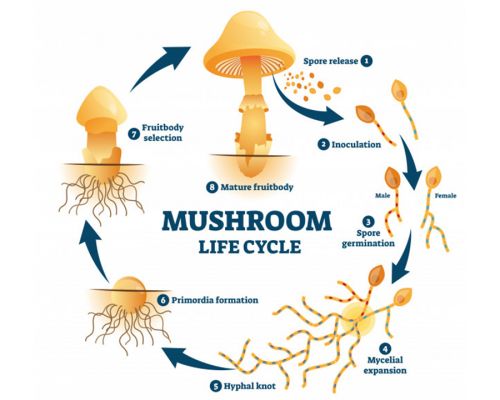
As you know, mushrooms start their growth from spores after substrate inoculation.
Then spores germinate and they have male and female spores! They literally create lovely pairs, connect and then form mycelium network. It lasts till there are enough nutrients for mycelium and mycelium wait for fruiting conditions.
The change from the vegetative growth (mycelium growth or colonisation period) to the fruiting period (knots, pinheads and mushroom fruit bodies development) is called knotting, pinning, pin setting or pinhead initiation period.
Pinheads or primordia are knots of mycelium that proceed their development into small mushrooms. That's why it is the most important phase in mushroom cultivation each grower waiting for it
Hypha, hyphae — individual cells of mycelium
Hyphal knot — individual strands of hyphae bundle together and prepare to grow a fruit body
Pin, pinhead — a very young mushroom, so-named for the pin-sized developing cap. Synonym with "primordium"
Primordium (pl. primordia) — the initial fruiting body, the first recognizable but undifferentiated mass of hyphae that develops into a mushroom fruitbody. Synonym with "pinhead"
🔴 Check out: Mycology Glossary & Mushroom Growing Abbreviations
All species require a set of conditions for pinning. They are quite different from the conditions for mycelial growth. Mushroom grower should understand the basic principles of pinning process and control changes.
Pinhead initiation in nature depends on climate conditions and seasons of the year.
In temperate and continental climates most mushrooms fruit during cool rainy spring and autumn. In tropical and subtropical climates mushrooms fruit during the rainy season, Psilocybe Cubensis and Panaeolus particularly.
The fruiting period is finished, when the season changed and climate conditions become too dry, too hot, or too cold. Then mycelium goes dormant, continue creating mycelium network underground and wait for better times. Mycelium wake up again when the relative humidity rises and temperature is suitable for fruiting.
Unfavorable conditions is the best time to expand mycelium network, absorb nutrients and restore energy reserves. As soon as tropical rains start again and temperature decrease these reserves are used for supporting mushroom fruit bodies development; and releasing spores to start the new cycle again
Basic principles of pin setting
Mushroom fruiting indoor response to the same conditions that trigger fruiting in the wild. Most of mushroom species require a few basic fruiting conditions:
✅ Fresh air exchange (FAE) is a main trigger for mushroom fruiting indoor
✅ Lower temperature than optimal for colonisation period in incubator. Usually, temperature drop is accompanied by rain in nature and increasing humidity level
✅ High relative humidity is necessary for pin setting and normal fruit bodies development
✅ Evaporation from top layer of mushroom cake/block. This process creates proper microclimate, maintain high humidity and one of the triggers for pinhead initiation
✅ Light. Although mycelium doesn't need the same light as plants, however photosensitive species require light for pin setting and normal mushroom metabolism
🔴 Pinning and mushroom development proceed if all these factors are in balance and coincide!
The relationship between primordia formation and yield
The pinning and primordia period is extremely important stage. Certain relationships exist between the pinning process and yields:
📍 During the primordia formation period, pinheads for the first and second flush are being generated.
About 60-75% of the total yield is normally harvested from the first two flushes. That's why the first 7-14 days in growbox for pinhead initiation are the most critical in the growing of mushrooms.
📍 The greater the number of pins set for the first flush, the higher the yield.
However, with more pinheads competing for the same nutrient base, the smaller are the mushrooms arising from it. Fewer pinheads result in larger mushrooms, but lower total yields.
📍 The substrate will only support the development of a certain number of primordia per flush.
Under normal circumstances with an even pin-set, pinheads may "abort" because of insufficient nutrients or late formation.
📍 Pins that form early delay the growth of neighboring primordia.
This can often be seen along the boundaries of the substrate container where primordia form or along the edges of the cake. At the same time, the rest of the mushroom cake remains completely bald. Sometimes these single primordia are removed to allow for even pin formation over the entire surface of the cake and to obtain a greater yield
Fruiting chamber for mushroom growing
Changing any of fruiting parameters can slow down or stop growing process at all. Therefore, grower should control fruiting conditions.
That's why we use different types of fruiting chambers to make it easier: GrowBox, MonoTub, Bottle-Tek, shoeboxes, SGFC (shotgun fruiting chamber), Martha tent or Grow Tent etc. All of them work great!
The choice is up to you!
Automated Growbox for small mushroom cakes or PF-tek mushroom cakes
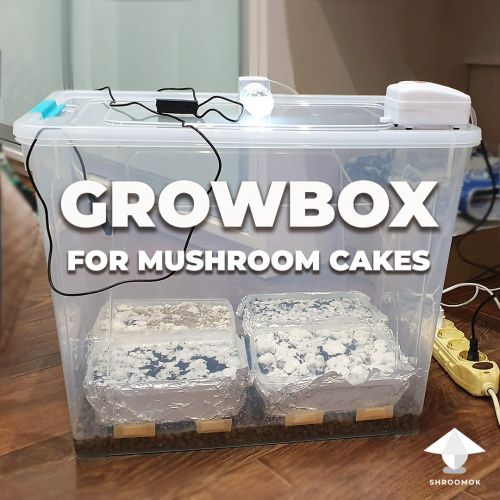
🔴 Detailed guide: DIY Grow Box for magic mushroom growing
Automated or modified MonoTub fruiting chamber. Make it properly and forget about manual FAE and misting
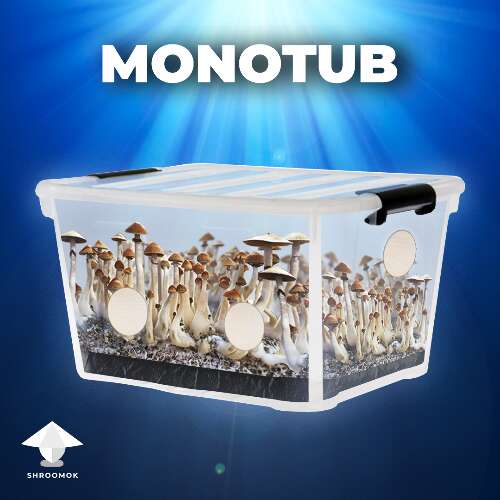
🔴 Detailed guide: How to make effective Monotub for Mushrooms by your own
One more option is Bottle-tek or growing in plastic bottles. This is a cheap alternative for Monotub and Growbox
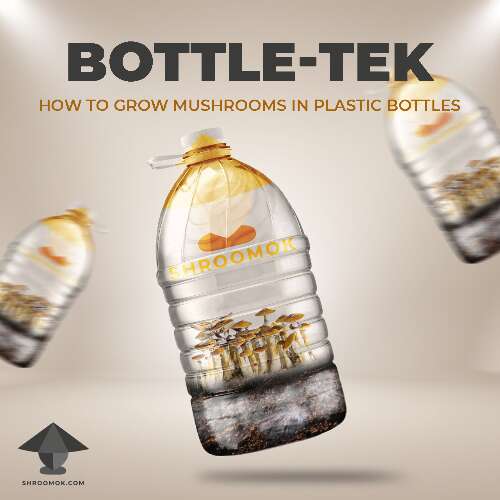
🔴 Detailed guide: Bottle-tek or how to grow mushrooms in plastic bottles
When you should start fruiting conditions
Keep air holes in fruiting chamber closed, keep you mushroom cakes closed. Don't provide fresh air and misting! Wait till the top layer of your mushroom cake will be colonised about 70-100%.
Let's check few examples to show you when it's time for fruiting conditions
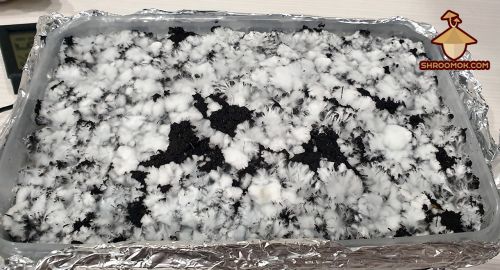
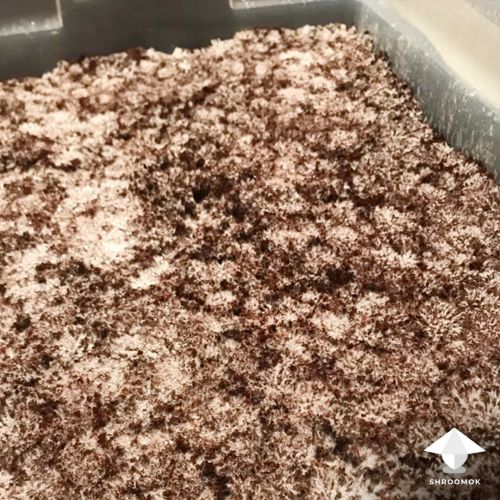
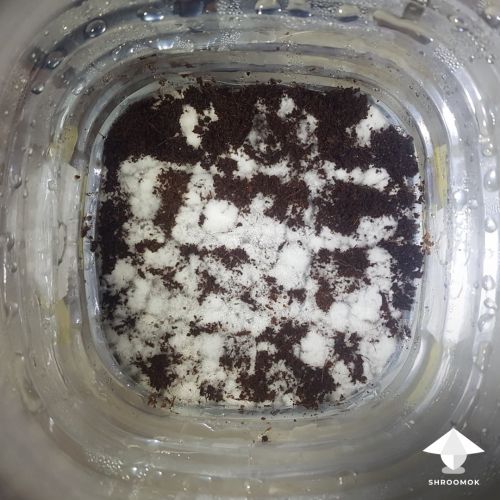
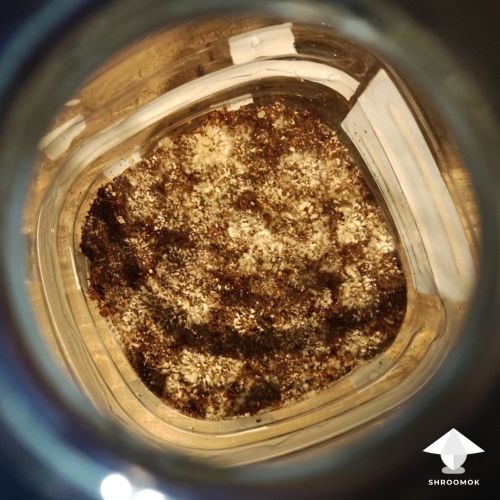
After top layer colonization you can provide fruiting conditions (FC): fresh air exchange (FAE), high relative humidity and light.
If you start earlier it takes more time for pinning, hence fruiting. Also higher risks of mold contamination, because molds like uncolonised areas on top layer and develop faster than mycelium. Easy to catch mold contamination during fanning the fruiting chamber.
Ideal fruiting conditions for pinning or primordia formation
After starting fruiting conditions for the first 5-7 days the mycelium seem like stalled and stop growing at all. It's totally normal!
Mycelium need time for adaptation, for switching mushroom "system" from colonization to fruiting.
The main task for you for the first 2 weeks of fruiting period is maintaining proper fruiting conditions:
❇️ Air temperature
Optimum air temperature for Psilocybe Cubensis in the fruiting chamber is +21°..+23°C or 70-74°F. The acceptable range is +20°..+25°C or 68-77°F.
For Psilocybe Natalensis +20°..+30°C or 68-86F and even up to 40C or 104°F. For Panaeolus species temperature range is +20°..+33°C or 68-91°F
At the lower temperature the growth can slow down significantly.
On the higher temperature there is a risk of activating contaminants and mycelium can switch back to the vegetative phase and provoke mycelium overgrowth aka overlay.
Due to mushroom metabolism mycelium itself heats up during the growing process. Temperature in the substrate can be 1-2° higher than air temperature in the fruiting chamber.
At this point, it will be sufficient to continue cultivation at room temperature. Of course, it depends on the temperature in your home. In the cold winter months heating may be needed (the same as for incubator). During summer months, it can be too hot and and you'll need cooling/air conditioning.
Control and measure temperature with an ordinary thermometer inside. Thermometer with hygrometer and CO2 sensor is really great to have.
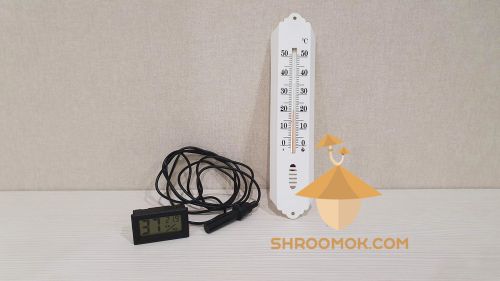
Shroomok's Choice on Amazon:
Digital Hygrometer, Thermometer with Remote App - $11.99
2-in-1: Professional Digital Hygrometer, Thermometer - $17.99
❇️ Relative humidity
Optimal relative humidity (RH) in fruiting chamber is 90-95%.
The acceptable range is 85-99%.
Use hygrometer to check humidity level. If you don't have hygrometer, then water drops on the walls of the tub is your sensor
To maintain required humidity level spray the walls of the fruiting chamber 1-2 times a day after FAE.
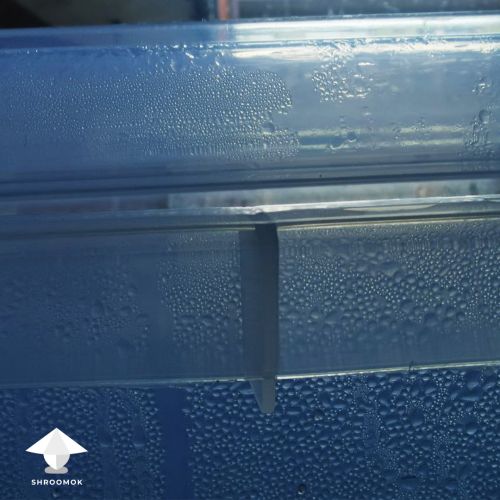
❌ Don't spray water on the mycelium and mushrooms directly! Control top layer of mushroom cake. It shouldn't be dry! At the same time avoid water pooling on mycelium. Skip misting if the walls of fruiting chamber are wet and/or you see small water drops on mycelium
The most simple and cheap method to maintain humidity is spray bottle with ultra fine water mist

Shroomok's Choice on Amazon:
Ultra Fine Spray Bottle, 10 oz, 300ml, Different Colors $8.99
You can also use terrarium humidifier or fogger. It can be programmed according to the intensity and frequency of spraying to maintain a constant humidity 90-95%.
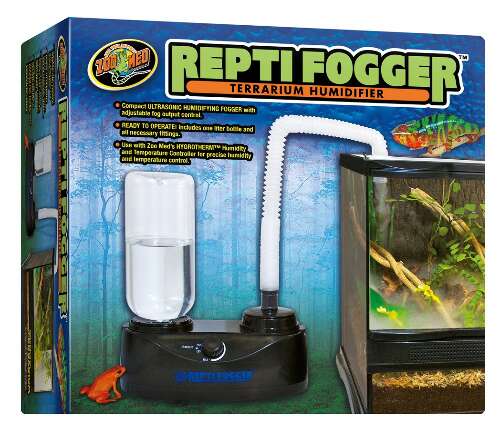
Shroomok's Choice on Amazon:
Fogger with Humidity Controller, Extended Hose, 4L $59.99
❇️ Fresh air exchange (FAE)
As you know mushrooms breathe with oxygen (O2) and emit carbon dioxide (CO2). Right after starting fruiting conditions the mycelium growth slows down and it produces less carbon dioxide until active phase of fruiting "turns on". It is necessary to introduce fresh air to initiate pinning.
Neglect tek
Properly made MonoTub doesn't need extra fanning. If the walls of the Monotub are wet, but you can see dry circle around air vents it means natural FAE works good for your fruiting chamber. You don't need additional fanning.
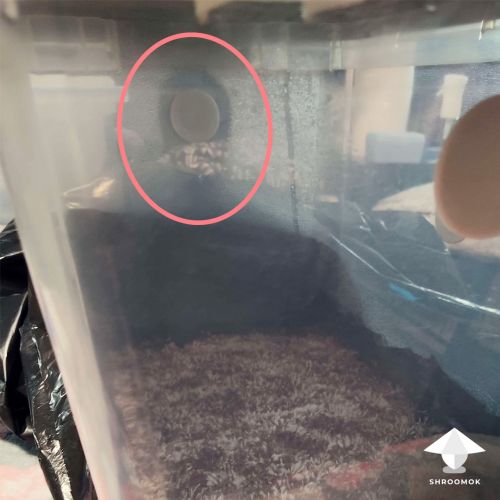
The same for properly made Bottle-tek. FAE through air holes is enough for mushroom pinning and further development.
Manual FAE
However manual FAE 2-3 times a day required for Growbox or if natural FAE doesn't work for your Monotub. Just open the lid of your tub for 1-2 minutes and make a few light moves with lid over the cakes. The smaller the tub the more often your should introduce fresh air.
Lack of oxygen is a common issue in mushroom growing. It can provoke cloudy fluffy, cottony mycelium growing called overlay or stroma. As a result you won't get mushrooms at all!
Stale air also provoke contamination. Mold contaminants mostly prefer stagnant air, while mushroom mycelium prefer fresh moving air. There is one more reason why you should provide constant FAE!
Additional automated FAE with aquarium air pump
Automated FAE in GrowBox (for PF-tek and small mushroom cakes tek) on a regular basis with aquarium air pump. Air pump also filter incoming air through water.
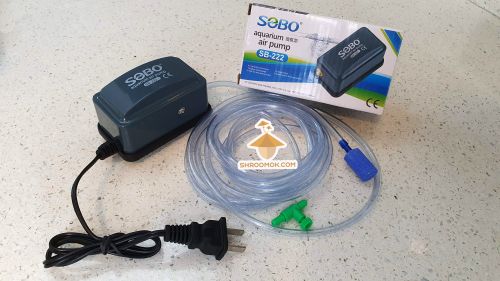
There is an aquarium stone at the end of the air pump hose, which must be dipped into water. In this way we filter incoming air.
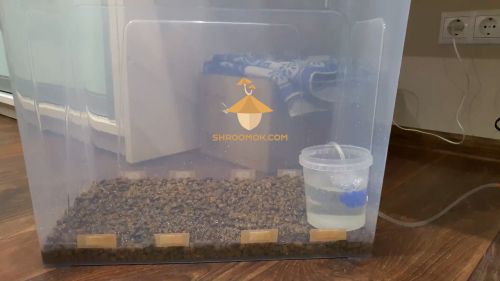
You can place bottle with air pump between mushroom cakes or make a stand for bottle
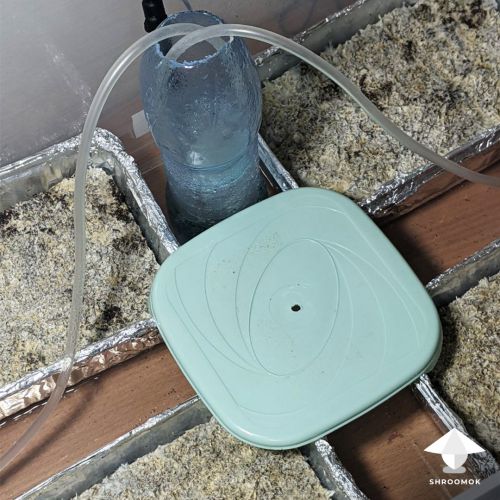
Here is an example of using air pump (in the bottom corner) for big mushroom cake in Growbox.
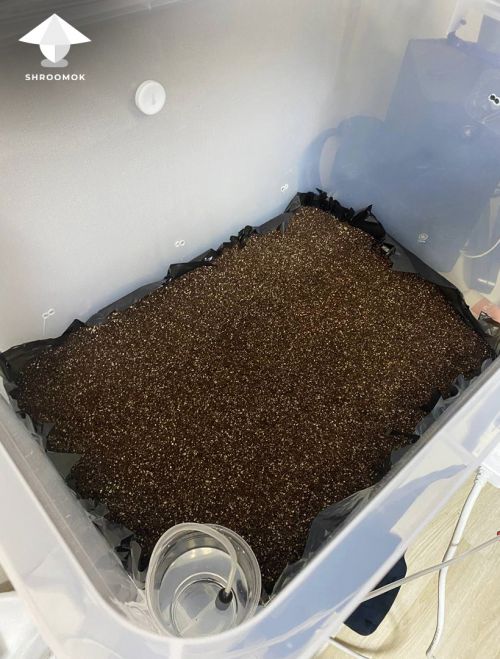
Finally fruiting!
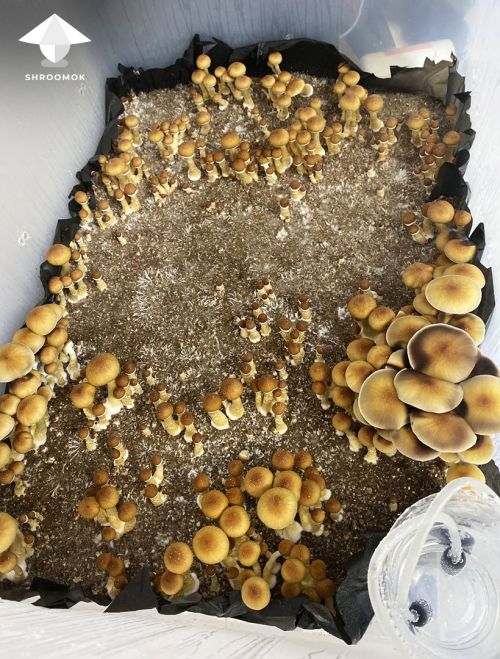
Shroomok's Choice on Amazon:
Adjustable Oxygen Pump for 20-100 Gallon - 2 Outlets - $14.99
Quiet Oxygen Pump for 20-100 Gallon - 2 Outlets - $15.99
Powerful Air Pump - for 20-200 Gallon - 2 Outlets - $22.89
PC fan for additional FAE
PC fan/cooler can be installed on the lid or on the wall of GrowBox/MonoTub. Size 60-120 mm is good to use. You don't need big or high speed fan
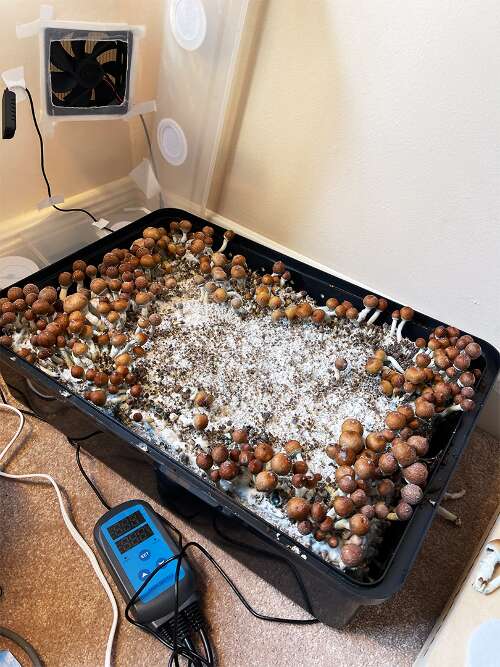
Shroomok's Choice on Amazon:
Quiet Fan with power plug cord $19.99
❇️ CO2 level
CO2 level is directly related to fresh air exchange. For normal pinning process CO2 should be 600-800 ppm.
❗️For a rough comparison normal outdoor CO2 level is 400-450 ppm. 600-800 ppm is the CO2 level in a closed room where few people breathe
All-in-one air quality monitor can be used for measuring carbon dioxide level, relative humidity and temperature in any fruiting chamber for mushroom growing
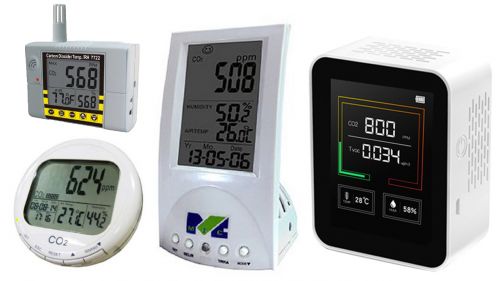
Shroomok's Choice on Amazon:
Mini CO2 Detector, Temperature, Humidity $45.99
Air Quality Monitor: CO2, Temperature Humidity $33.17
❇️ Light
Optimal is 12 hours on/off cycle
Mushroom species that require light to form pins are considered photosensitive. Although light is not necessary for the induction of fruiting in fungi, some spectra have been found to be stimulating for the initiation of pins and are essential for the normal development of the fruiting body.
For example, Psilocybe Сubensis and Panaeolus are such photosensitive species.
🔬 A thorough investigation on the photosensitivity of Psilocybe Cubensis can be found in a master's thesis by E.R. Badham (1979). His work reinforces the conclusions of other researchers working with the Basidiomycetes: more pinheads are initiated upon exposure to blue and ultra-violet light with distinct peaks at 370, 440 and 460 nanometers
🔬 Badham showed that light stimulation at these wavelengths for as little as half a millisecond per day caused primordia to form. In contrast, red, infra-red and green light having wavelengths greater than 510 nanometers were ineffective
🔴 Natural light is suitable, but only diffused soft light. Avoid direct sunlight!
The optimal lighting cycle for psilocybin mushrooms during the pinhead initiation is 12 on/off cycle. Light should be white-blue spectrum (~435-480 nm) or use fluorescent light 6500k lux power.
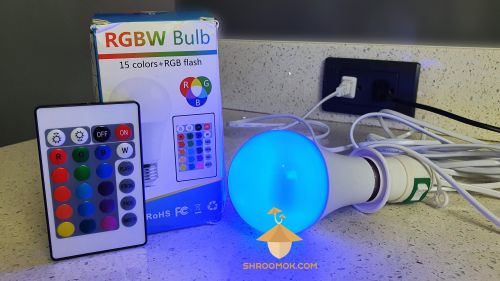
Diode LED lamp or LED light strip is suitable
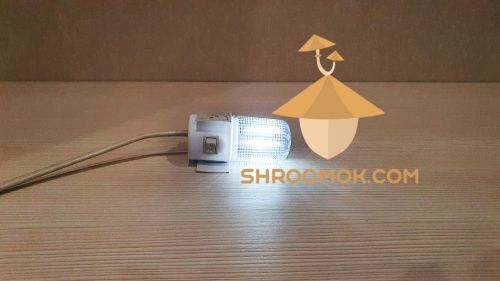
Any lamps with cold white light 6000-6500k is suitable. No need to use powerful lamps for plants
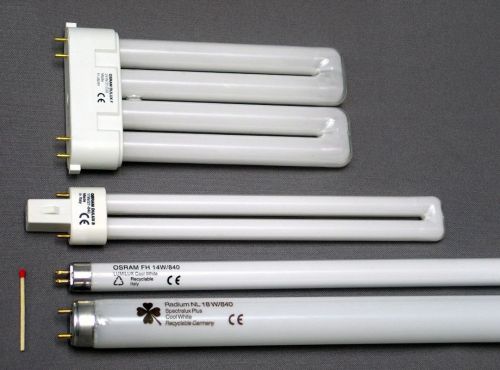
Use light inside or outside the fruiting chamber.
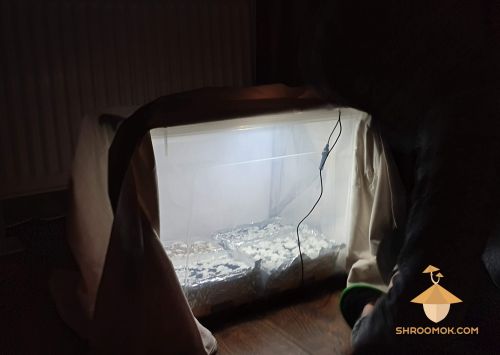
Shroomok's Choice on Amazon:
LED Desk Lamp with Flexible Gooseneck $16.99
LED Light Strip, 6500K - 16.4ft $19.99
LED light bar Under Cabinet Lighting with Touch Switch $22.99
❇️ To improve your growing process and make automated air conditions monitoring in growbox you can use different sensors, humidity and temperature controllers, timers and all sorts of gadgets. It's up to you. The sky is the limit!
Great thing to use are on/off timer and smart plug, so that you can connect all your devices with Remote Control that helps to be informed and change growing conditions from anywhere! Most of them are compatible with Alexa, Echo & Google Home. Or use on/off timers
Shroomok's Choice on Amazon:
Smart WiFi Heavy Duty Outdoor/Indoor Outlet, Timer - 3 Outlets - $16.99
BN-LINK Short Period Repeat Cycle Intermittent Timer $26.99
Digital Controller for Temperature, Humidity, Timer $49.99
How to identify start of pinning and mushroom growing
Knots, pins, primordia examples
All this meditation take up to 2 weeks. As a rule, the first flush of fruiting starts on the 7-14th day.
During the first days in the growbox/monotub it seems like mycelium completely stalled and stop growing. It's totally normal! Because mycelium needs some adaptation period to new climate conditions
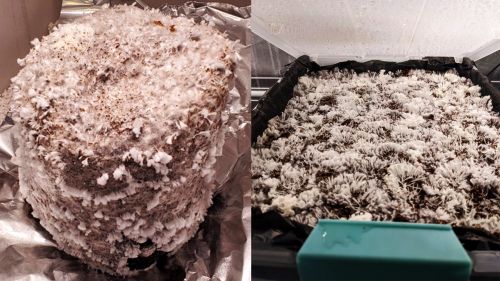
On the first stage (7-10 days after providing fruiting conditions) you can notice how the mycelium threads turn into small balls
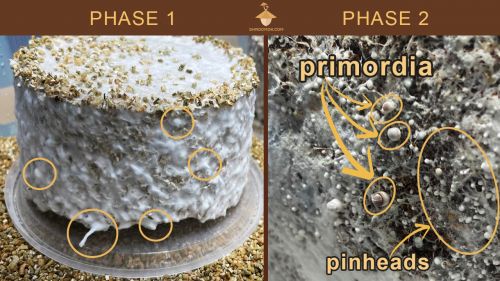
At the second stage (7-14 days days after providing fruiting conditions) knots become more tender and form pins aka primordia. Then these pins continue their development into full-grown mushrooms.
In the photo below, the 28th day after inoculation and only 4 days after providing FC. You can see small pins on the mushroom cake. Although the mycelium didn't cover the entire casing layer tightly, in fact, such mycelium (rhizomorphic type) is ideal!
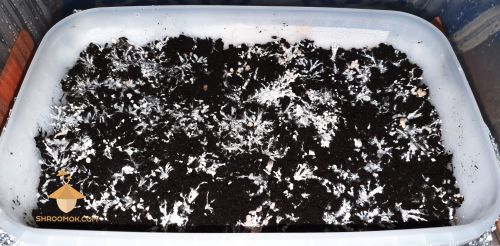
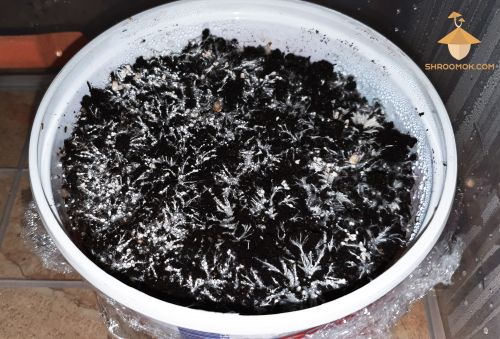
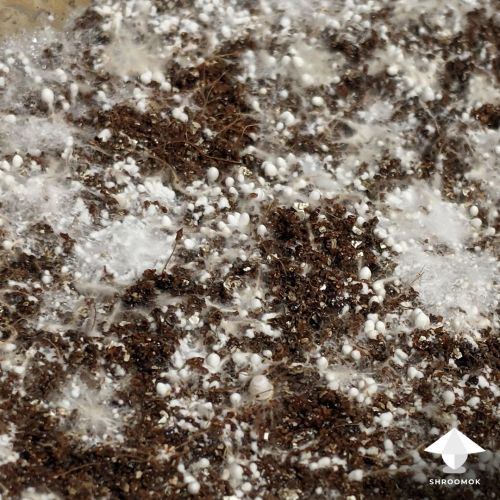
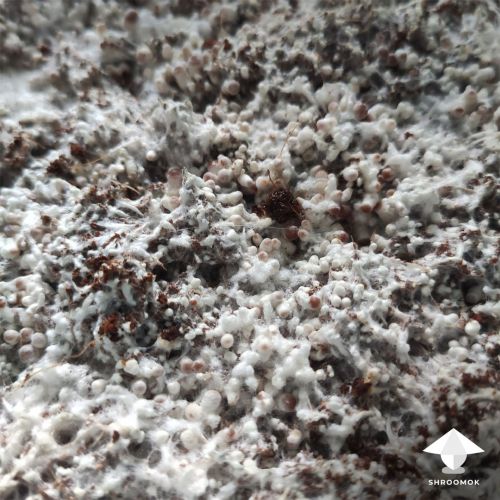
Cold shock for pinhead initiation
Cold Shock — is a procedure when the colonized mushroom cake is stressed by a sudden drop in temperature — for 12-24 hours in the refrigerator at +2ºC to 4ºC (35-39°F) BEFORE introducing fruiting conditions (FC).
This method has advantages and disadvantages for such warm-loving species like Psilocybe Cubensis.
Briefly, cold shocking is a trigger for pinheads and speed up fruiting.
At the same time cold shock can provoke many aborted mushrooms. That's why this method never used for Panaeolus and 50/50 for P. Cubensis.
🔴 Details: All you need to know about cold shock for magic mushrooms
Don't use cold shock for all your cakes. Try to make an experiment with 1-2 cakes to see if it works good or bad in your case.
For example here is Psilocybe Cubensis Thai mushroom cake. 9 days after cold shock and providing FC. 28 days after grain inoculation for spawn and we already have small mushrooms.
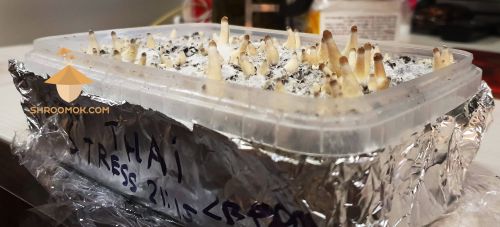
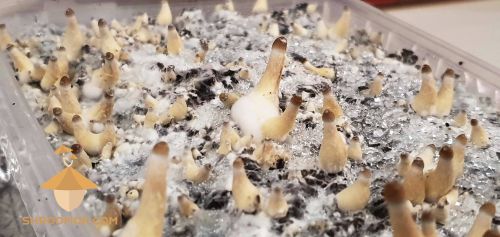
Blanket tek or bubble wrap for pinhead initiation
Sometimes you have such case in mushroom growing:
14 days passed after providing fruiting conditions, but you still don't have pins at all. Mushroom cake is totally healthy, there are no signs of contamination. You are sure there is no overlay or stroma. Fruiting conditions are perfect
In this case you can use blanket tek aka bubble wrap tek for your mushroom cake
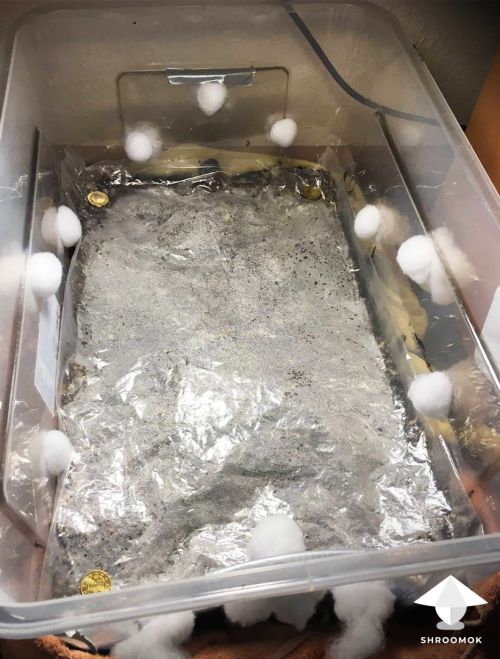
Take a food film or bubble wrap.
Spray water on film (use Ultra Fine Spray Bottle to have small water drops)
Put film or bubble wrap on mycelium like blanket. Film can contact and touch mycelium, don't afraid to do this!
Keep temperature about +21°..23°C or 70-74°F, light 12 hours on/off cycle.
Remove PE film twice a day to introduce fresh air and check the mycelium.
Usually in 3-5 days you can see first pins. From this moment remove the film and provide normal fruiting conditions for pins development (FAE, high relative humidity, light).
This method also works great if you started fruiting conditions too early, or top layer becomes dry, or no pinning after 14 days of fruiting conditions
Fruiting parameters for mushroom growth
When primordia 3-5 mm in size are formed on the mushroom cake (usually this happens after 7-14 days), then the fruiting parameters should be slightly adjusted.
These conditions should be maintained until the harvest.
❇️ Air temperature in growbox remains stable within the range of +21°..+23°C or 70-74°F (for Cubensis).
❇️ Relative humidity a bit lower - 90-92%.
❇️ FAE more frequent 3-6 times a day. Under no circumstances should air stagnation be allowed. High humidity and lack of air movement are an excellent breeding ground for pathogenic microorganisms and infection of mushroom cakes. Ideally - the operation of the aquarium air pump or use PC fan every 2-3 hours for 2-3 minutes on slow mode
❇️ CO2 level no more than 1000 ppm. At the stage of growth of fruiting bodies, fungi emit more carbon dioxide, but a slight increase in the level of CO2 in the grow box is less critical than at the stage of pinning.
❇️ 12 hour on/off light cycle. Diffuse natural light or exposure to a blue-spectrum LED lamp (~435-480 nanometers).
🔴 The top layer of mushroom cake should be moist enough. At the same time avoid puddles!
Mushrooms development in dynamic
I'd like to share some examples. Here is Golden Teacher in all its glory. This handsome shroom guy appeared the very first.
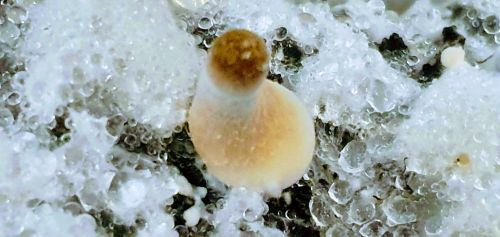
7 days in the fruiting chamber after starting FC, 26 days after inoculation
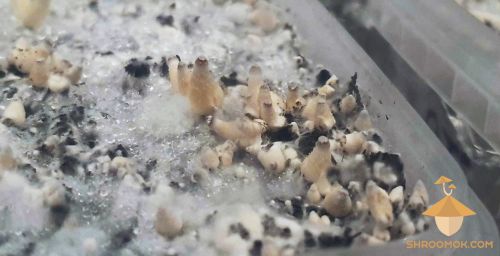
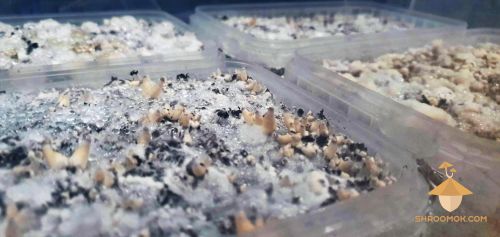
Mushroom meme with our funny fungi guy
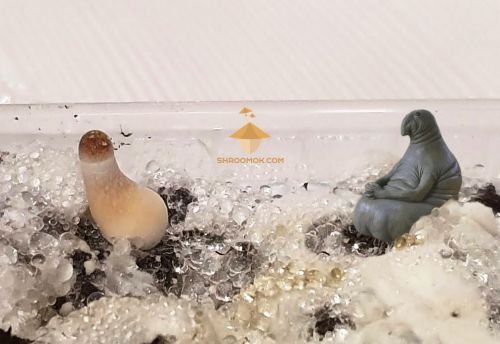
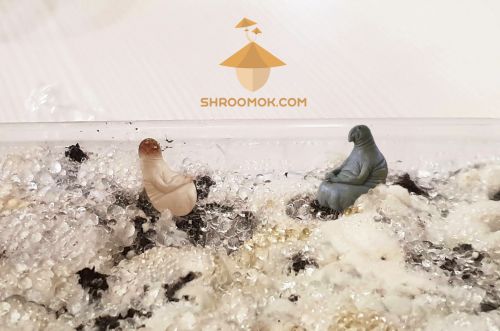
10 days after FC, 29 days after grain inoculation
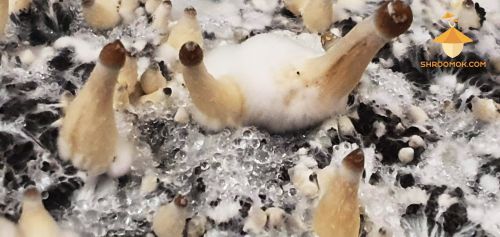
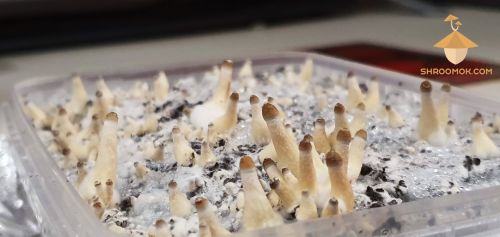
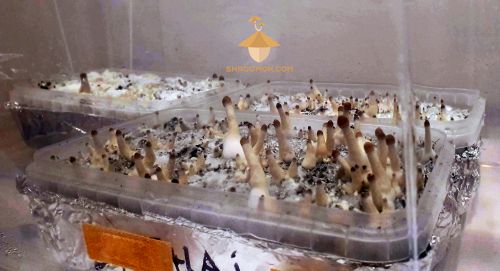
30th day after inoculation and 8th day of fruiting period:
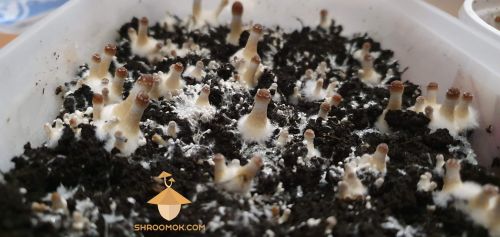
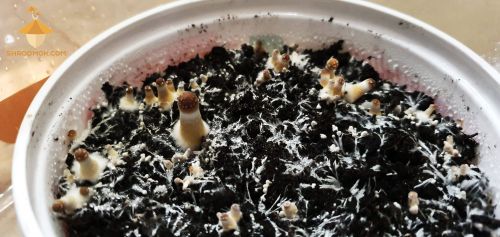
Here you can see fluffy base of stems aka fuzzy feet. It is an exact sign of high CO2 concentration in fruiting chamber and your mushrooms need more FAE
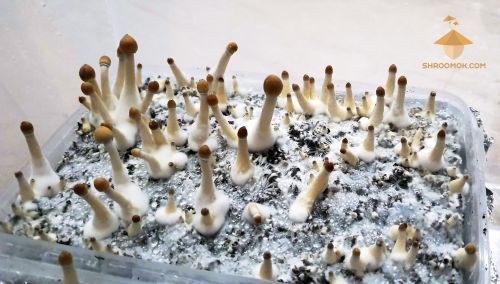
Growing problems during mushroom fruiting period
During fruiting period you can face with many problems. Most common are:
- Wrong fruiting conditions: problems with pin setting and primordia development, overlay, mushroom aborts, metabolites, abnormal development of fruit bodies
- Contamination with pathogenic microorganisms: molds, bacteria, viruses, parasites
- Genetic problems: mutation, abnormal development, strain degeneration, stroma
🆘 Why mycelium turned blue and have bruises
Newbie cultivators often confuse mycelium oxidation and mushroom bruises with contamination. Bruises is a reaction between oxygen and psilocin in mushrooms and mycelium. Bruises are not contaminants and nothing to worry about.
Blue color can occur due to any damages or if you touch shrooms or mycelium. Bruises appear due to hard fanning as well
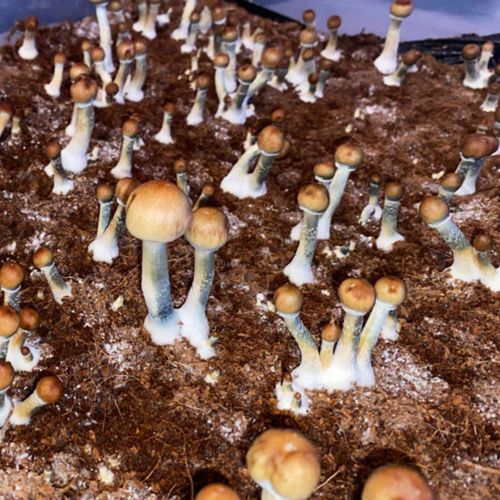
Bruises on mycelium can appear due to lack of moisture in the substrate or casing layer. As a result mycelium torn and become blue.
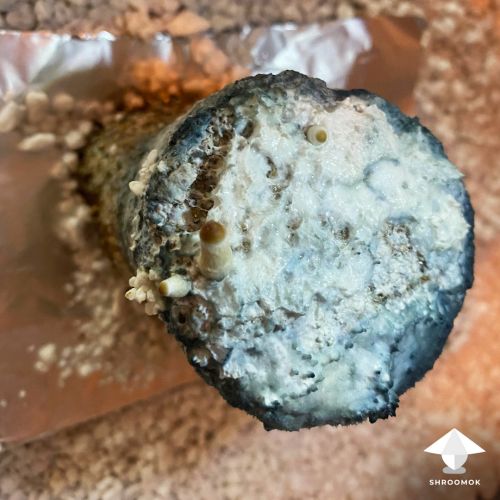
It's normal reaction when you crop mushrooms.
Bruises often confuse with green mold Trichoderma and blue mold Penicillium
🔴 Recommended: Mycelium Bruises or Mold Contamination
🆘 Mycelium is cloudy, cottony, fluffy or crust-like
Stroma and Overlay is a dense cottony mycelium forms on the surface of the casing layer.
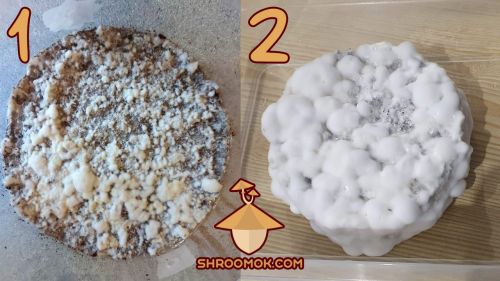
Some time later it can turn into a crust. Such mycelium doesn't allow moisture and air to pass through and prevents pins and primordia formation.
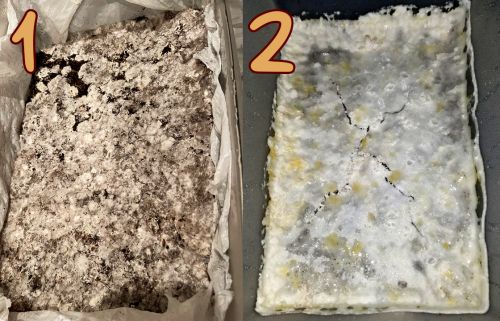
The main cause of such situation is lack of fresh air in fruiting chamber with too low or too high relative humidity. Also dead zones in MonoTub due to improperly made MonoTub chamber
🔴 More examples and how to fix it: Overlay and Stroma in mushroom cultivation
🆘 Top layer and mycelium too dry
Dry mycelium can't form pins at all or pins can't develop mushroom fruit bodies. Dry mycelium usually has greyish color
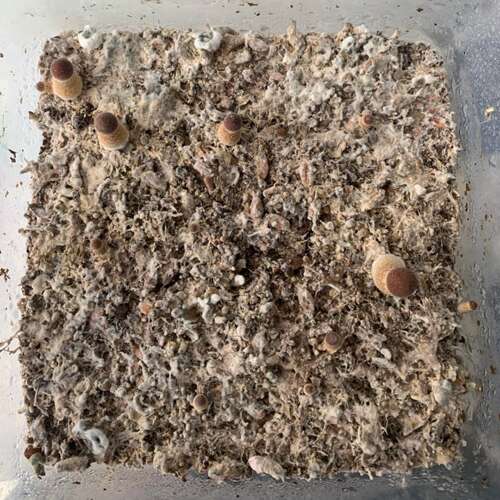
In this case you have high relative humidity in fruiting chamber (sometimes 99%), but this high RH is maintained by high evaporation level from top layer. As a result your mushroom cake dry out.
One more reason is fanning without regular misting (or without using humidifier).
Also hard fanning or too much fanning with PC fan or air pump can provoke such issue.
Try to keep fruiting conditions in balance! If it doesn't work, then rehydration aka soaking in water is the best solution for dehydrated mushroom cakes
🔴 Recommended: Rehydration or how to soak mushroom cake
🆘 "Dead zones" or ineffective MonoTub
It is a common issue for monotub configuration. If air holes or air gaps were made improperly, then natural airflow won't work. It cause:
Contamination due to poor air flow, contaminants prefer stagnant air
Overlay due to high CO2 concentration and lack of FAE in fruiting chamber
Overlay in the corners of tub aka dead zones. Usually you can see dry mycelium in the centre, where hard fanning and overlaid parts where no air flow at all and too wet
Dry top layer, when relative humidity in monotub is high. This case is always confused, because hygrometer shows 90-99%, but top layer becomes dry. It means relative humidity maintained mainly by evaporation from top layer and goes away through air holes extremely fast. As a result we have dry top layer, dry mycelium, problems with pinhead initiation or problems with fruit bodies development
🔴 Recommended: How to make effective Monotub for mushroom growing
🆘 Too wet mycelium
Small amount of tiny water drops on mycelium is normal. But sometimes you can see excessive water drops or even puddles on mycelium after using humidifier.
Excessive moisture can cause bacteria blotch disease, overlay or inhibit pins development.
In this case don't mist and don't use humidifier for 1-3 days, but provide FAE as usual.
Sometimes fresh air or slow mode fanning for 10-20 minutes helps to dry out excessive water drops.
🆘 Mushroom caps turned black
Mushroom aborts are primordia or young mushrooms that have stopped their development. A distinctive feature of aborted shrooms is black mushroom cap
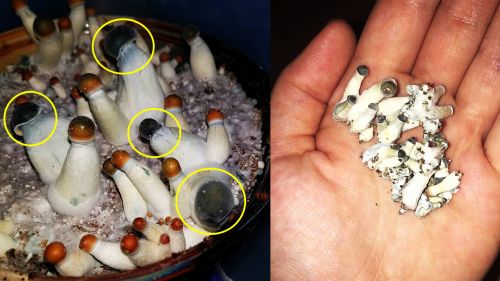
🔴 More details: Mushroom aborts
🆘 Yellow liquid on mushroom mycelium
Transparent yellow-orange-brown liquid without slime and smell are secondary metabolites or waste products of the mycelium.
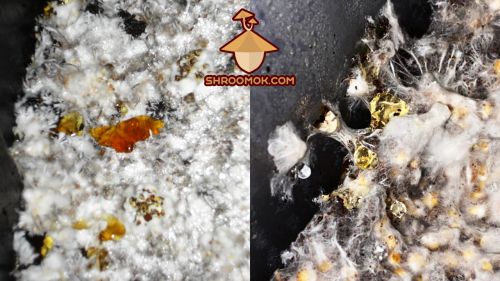
Often formed due to stress: temperature changes, drafts, direct sunlight.
Mycelium metabolites can be caused by minor contamination, usually bacteria. As a result of fighting between mycelium's immune system against competitors metabolites appear.
Metabolites are often confused with contamination called Mycogone (aka Wet Bubble).
🔴 Details: Mycelium metabolites or mushroom pee
🆘 Mycelium become yellow, beige or brown
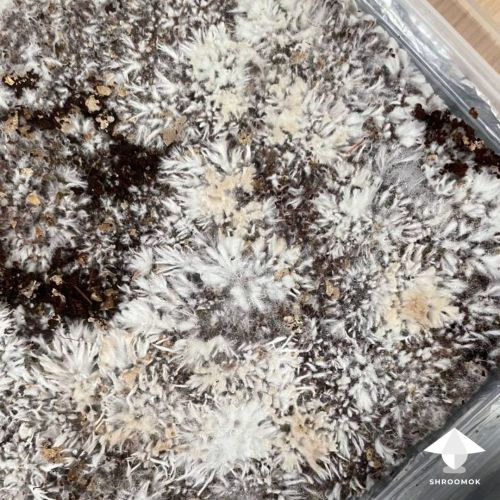
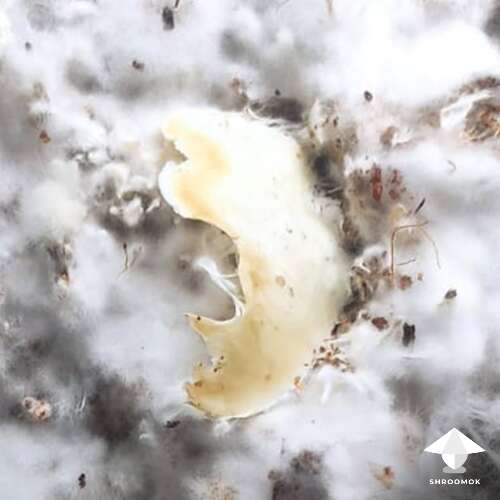
Slight pigmentation (beige, yellow, brown mycelium) is a normal reaction due to release of mycelium waste products. Nothing to worry about. It's not contamination.
However, it is important to differ it from yellow mold and mycogone contamination
🔴 Details: Mycelium metabolites or mushroom pee
🆘 Fuzzy feet, white dots on mushroom caps and long stems
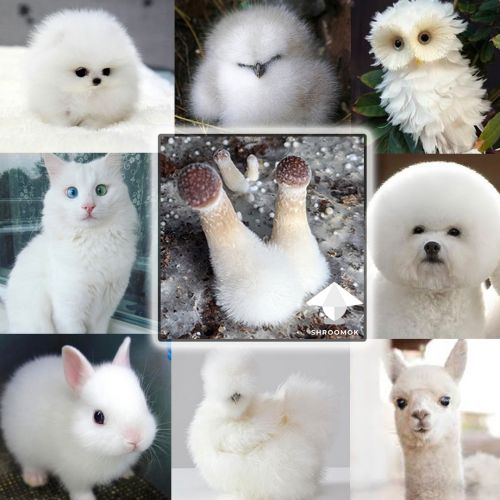
🔴 Check out: Why Mushrooms too Leggy, Fuzzy Feet and White Dots on Caps
🆘 Dark spots on mushrooms and mycelium
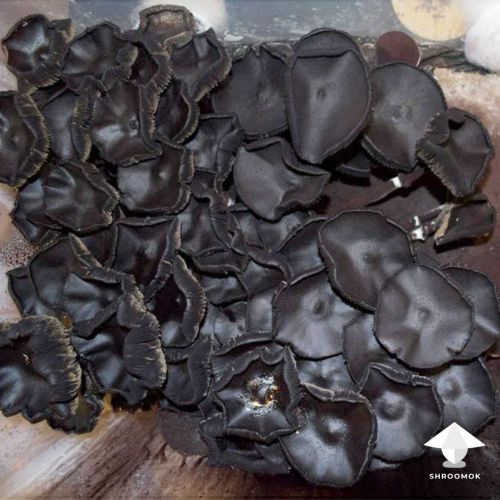
🔴 Check out details and examples: Black spots on Mushrooms and Mycelium
🆘 Green Mold contamination
Green mold the most common contamination in mushroom growing. This mold is white form the very beginning, then turn green color. Actually it is easy to identify early Trichoderma contamination.
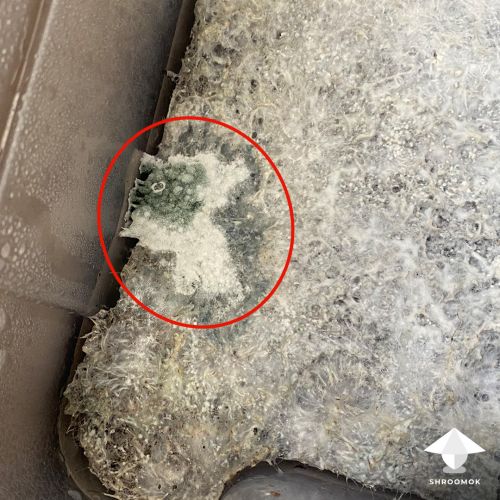
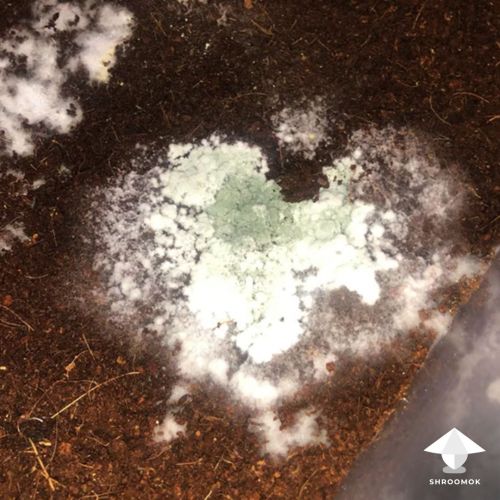
🔴 All about Trich contam: Green mold contamination aka Trichoderma
🆘 Cobweb Mold contamination
Thin greyish fast growing mold contamination on top layer
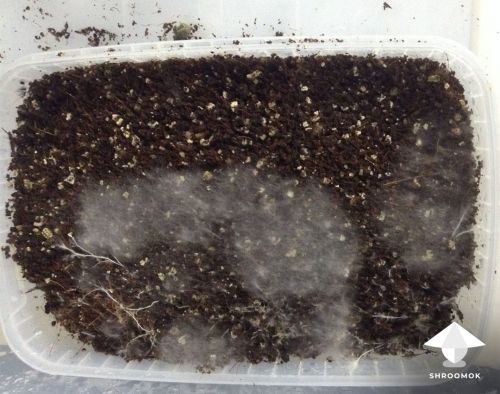
🔴 Check out details: How to identify and get rid of Cobweb Mold
And 1000 more issues you can face with. Check out full Growing Troubleshooting and Contamination Library
🔴 Recommended: Growing Troubleshooting and Mold Contamination Library
Stay tuned!
Wrap it Up!
Mushroom cultivation is about balance!
Pinning and mushroom development proceed if all fruiting conditions are in balance and coincide!
This is general overview of growing conditions and possible problems.
Each case is unique in home cultivation. A lot of factors influence on your growing process: growing tek, the volume of fruiting chamber, temperature outside and inside your fruiting chamber, ventilation in your room, drafts, climate and season of the year in your country, contamination concentration and contam variety in your room etc.
For successful pin setting and mushrooms development you should maintain necessary microclimate in the fruiting chamber, avoid and prevent possible contamination.
Identify contamination in time!
Be patient and attentive to mushroom language, so that you can prevent or fix many growing problems.
The exciting harvesting moment are coming soon...
After primordia formation mushrooms are ready for harvesting in 5-10 days.
But before harvesting I suggest to prepare your own spore prints for new mycological experiments.
Move on — Step 11. Day 32-33. How to make spore print
Join Shroomok Community on Discord and Reddit for questions and sharing your experience.
If you find this guide helpful support my work with subscription or one-time donation on ☕️ buymeacoffee
Have a happy growing!
Peace, Shroomok ❤️


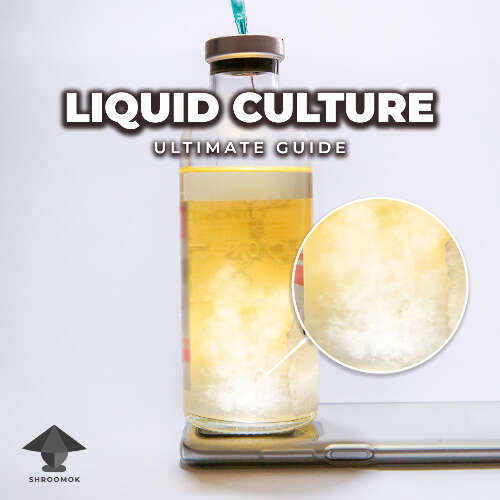

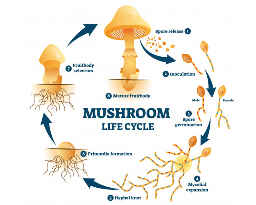
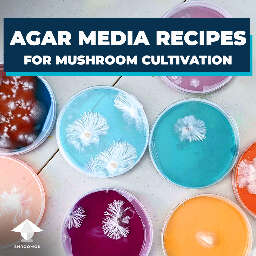
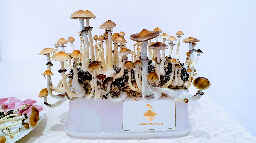
Comments
Thanks for taking the time to write this out, im sure this will help many ppl just like me and make the world an even more amazing place!! 🍄❤️🙏💊
@Happy_cappy What a kind comment! I’m happy to know this guide is useful to you. All my love and thanks to you ❤️
Along with psilly girl, these guides are the most thorough and well documented resource i have found. I lost a couple grain bags to contamination along the way, but now have a run of four productive batches (Penis Envy, Golden Teacher, AA+ Leucistic, and an "APE" that was actually something else browner and smaller and milder, but which works just fine at volume. (all from innoculatetheworld). I tried spore prints and pressure cookers in the mid-90's with spotty results, but the state of the community and ease of cultivation have multiplied exponentially. Thank you.
That’s so nice of you, @axlotl. I’m so glad you enjoyed my resource. Thank you for warm word, and thanks for sharing your story. Feel free to update ;)
Have a happy growing journey 🙌
Amazing article. Not gonna lie saying it saved my crops because I got too emotional 😅 I have a question though - what would he the best temperature to set on a heating mat?
@Jake, you don’t need a heating mat for the fruiting period if your room temperature is between 68–75°F (20–24°C).
If your room temperature drops below 68°F (20°C), set it to around 73°F (23°C). That should be sufficient.
For bulk colonization period - 73-80°F (23-27C).
I’m afraid to open my lid. I live in an old house in a cold/damp climate and have not yet had a successful grow because it always gets contaminated despite dousing myself in rubbing alcohol and wiping everything down always when working with the monotub. I’m sure it’s in the air. I’m trying to keep the lid shut and rely on the humidifier, filter disks and the fan to do the work, but pinning hasn’t started and it’s been 13 days. Whats the minimum amount of fanning I can do?
This was super informative! Been growing for a couple of yrs now and am always learning new stuff. Great article here, very good info. Great job !!! Keep em growing!!
Add comment